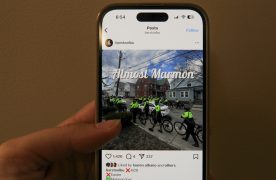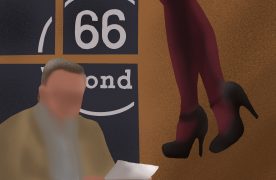Way back in 1982, when the Artist-Still-Known-as-Prince was the Next Big Thang, before Madonna had conquered the world, while the King of Pop was celebrated for his revolutionary music and not reviled as tabloid fodder, a little group by the name of Men Without Hats spread a big message across the world:
‘We can dance if we want to, we can leave your friends behind / Cause your friends don’t dance, and if they don’t dance / Well they are no friends of mine. / I say, we can go where we want to, a place where they will never find / And we can act like we come from out of this world / Leave the real one far behind.’
Truer words about the current state of cultural affairs have never been uttered, my friends.
Welcome to the year 2002, otherwise known as ‘The ’80s: Redux.’ As the ever- evolving retro movement moves forward, we have managed to eat our way, like locusts, through the major cultural movements of the ’60s and the ’70s in a frighteningly small amount of time. All hail the end of techno (tastes just like disco)! Ding dong, bellbottoms are dead (again)! And we’re all so sorry to witness the stillborn birth of that mutant hybrid known as rave culture (neo-hippie free love revolution? Ha! Smells more like teen spiritlessness to me)! Where does that leave us? You guessed it: The ’80s.
Beyond the simple fact that the recently-deceased decade of Reaganomics and Pac Man is next in chronological order, the rebirth of all things `80s signals something about our current state of affairs. Look around and you’ll recognize all the familiar signs. The high paying, cushy dot com jobs of yesteryear have vanished. That here today, gone later today idyll of opulence and self-indulgence known as the late ’90s has left the building. For good. After the bottom of the market fell out everyone went broke, flat broke.
And it doesn’t just stop there. That’s right not only are we in the midst of a recession, but threats of all kinds loom over our pretty little collective head, i.e. terrorism, nuclear warfare, biochemical warfare, kidnapping, snipers and, oh yeah, basically any disaster of global proportions that your overloaded, paranoid, neuroses-driven mind can dream up. In this age of constant mutability, where the line between conspiracy and coincidence, between fiction and fact, has been unrecognizably blurred, only one thing is certain; the need to escape has returned, with a vengeance.
In the season premiere of ‘The Sopranos,’ crime boss extraordinaire Tony astutely observes, ‘The only two businesses that are supposed to do well in times like this is [sic] show biz and our thing, and it’s been that way since time immemorial.’ Now that the economy has hit a brick wall, anyone remotely associated with vice and escapism is cashing in. During a decade of cartoonish economic booms, where bankrolls soared through the roof and into the stratosphere, the entertainment industry flopped and floundered. In our current age of unsure futures and economic hardships, though, Hollywood has seen a 200 percent increase in revenue, the music industry is back and Joe Schmoe survives the bleak workweek with the promise of club hopping and neon-drenched sexcapades during the weekend. What else are you supposed to do?
The ’80s, with its wild, escapist, hedonistic ethos, provides the ideal backdrop to a party-’til-you-drop lifestyle. The current trend toward the decade rears its tacky, giant hairdo-ed head in the most outrageous places. Take the music scene, for example. The electroclash ‘movement’ has gained momentum this year, garnering much attention in high gloss mags like Vogue, Spin and The Fader Magazine. This brand of techno-influenced new wave combines with sleazy, ‘meet you in the bathroom stall on the right’ sexual politics to create unflinchingly racy music-and one helluva good time.
The eclectic, ’80s-obsessed women associated with Electroclash have a knack for spotlight stealing. What is it about Ladytron, a four-person androgyny-fest that crafts cold, gloriously impersonal synth pop that was supposed to take over the world back in ’82? If you happen to fall prey to the droning beat, to the icy vocals, I challenge you figure out who’s a boy and who’s a girl. Or what about W.I.T., three glamorous girlie girls who signal the second coming of the almighty Debbie Harry? They don’t need to play instruments. They just sing covers of Gary Newman songs, do the Robot and wear guitars as props. It’s ‘conceptual.’ Get it? And nobody questions the attention thrown at Peaches, a Canadian folk artist turned terribly filthy, drum-and-bass cult darling. Song titles like ‘Skittle My Dittle’ and ‘F- the Pain Away’ seem to say it all about this potty-mouthed descendant of the queen of antics, Wendy O. Williams. Oh, and she wears a mullet.
The desire to escape from a harsh reality doesn’t end here. Look at Rockstar Games’ latest release, ‘Grand Theft Auto: Vice City,’ the highly anticipated follow-up to the definitive shoot-em-up car game, GTAIII. ‘Vice City,’ which is set in the ’80s, boasts all the perks of its predecessor the city is a wholly independent environment that lives and breathes on its own with added twists. More gratuitous violence (you can choose between a golf club or a chainsaw as your weapon) and realistically complicated storylines make for superior gameplay that quickly envelops your mind.
After playing for more than a half hour, you become a part of this fully functional city. Sit back and watch, as citizens are late for work, as cabbies pick up customers. If you chose to play a more active role and run over a slew of pedestrians, the police will hunt you down but it’s your choice. Just like real life. In fact, the only difference between Vice City and real life is that in the video game, you have ultimate freedom and control. You have somewhere to go and something to do. You can escape.
We can dance if we want to and leave this troubled, sorry excuse for a world behind. The rise of countless ’80s nights at clubs like Axis and the Matrix, and the devotion of entire establishments to synthesizers and new wave classics, like Polly Esther’s Culture Club, show the unquenchable thirst for retro escapism.
These days, the hottest, trendiest clubs don’t resemble the techno drenched breakdance havens that took over a few years ago they seem more like the heyday of that Mecca of fabulousness, that pansexual dreamscape thought up by none other than Caligula himself: Studio 54. Daylight may prove harsh and blinding, but anything is possible under the influence of a discotheque’s smoke and mirrors. Indulgence seems incredibly attractive when the future feels unsure, when tomorrow could bring disaster.
Of course, movements in music, fashion and nightlife evolve rapidly with politics and economics, and tastes for certain retro trends fade as quickly as they develop. As it gains momentum, America’s obsession with retro-ism and cultural recycling will surely die out sometime soon-after early nineties nostalgia burns up and fades away, will we experience revivals of retro periods gone by? Hopefully, some different cultural mode, some new directions in culture will prevent the painful, ultra-ironic reheating of already stale leftovers. But until then, my friends, we can dance if we want to, and leave this world behind.
This is an account occasionally used by the Daily Free Press editors to post archived posts from previous iterations of the site or otherwise for special circumstance publications. See authorship info on the byline at the top of the page.












